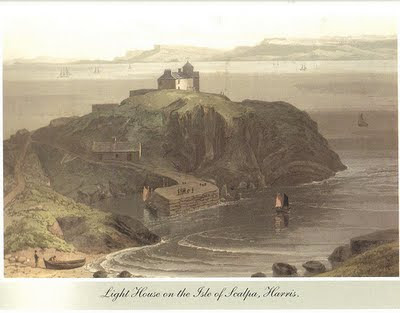 |
| Mingulay / Miughalaigh 1888 |
Another short historical anecdote taken down by Alexander Carmichael probably from the recitation of Roderick MacNeil, nick-named Ruairidh an Rùma, tells of the time when plague visited the remote island of Mingulay
About 300 years ago ten families lived in Mi[ng]ulay
One time in win[ter] the MacNeil of the day won[dered] that he
was see[ing] no per[son] from Mi[ng]u[lay]. He sent a boats crewOne time in win[ter] the MacNeil of the day won[dered] that he
to in[vesti]g[ate]. The boat came over and land[ed] and sent
up a man the name of MacPhie. When he came
to the houses which then stood on a rocky Bun[?]
N[orth] E[ast] of the pre[sent village] he found all within dead. He
ret[urned] to his com[panions] who were keep[ing] the boat. They as[ked]
him what news. I’ll tell that pre[sently] said Mac
Phi not a bone of your bone [recte: body] shall come
in till you tell us first. as he would
not do so the boat left him and ret[urned] to Cas[tlebay]
and told MacN[eil] For 7 w[eeks] no other boat was
able to come. In the mean[time] Mac[Phie] went to the
hill op[posite] Bearn[aray] where there was a hut where
the sheep shelt[ered] dur[ing] snow. He got hold
of some sheep skin and made a cov[ering]
for himself and used the fat of the sheep
when frozen as food. When MacN[eil] came fire
was set to all the huts and the dead bod[ies] were
burnt. MacN[eil] asked MacPh[ie] if he were
committed[?] an[d] live in Miul[ay]. He said he wo[u]ld
and chose 3 or 4 trust[y] frie[nds]. They built the
huts down on the stran[d] but from
this the pred[?ecessors] of the p[?opulatio]n had to remove
on acc[ount] of the en[croachment] of the sea. Ruary saw
a man to whose house the sea was
ap[proaching]. He left his old moth[er] in his [hut] and
had not got six y[ar]ds from the ho[use] when a
sea came and left not one stone.
Reference:
CW 114, fos. 63r –64v.
Image:
Mingulay / Miughalaigh 1888.











